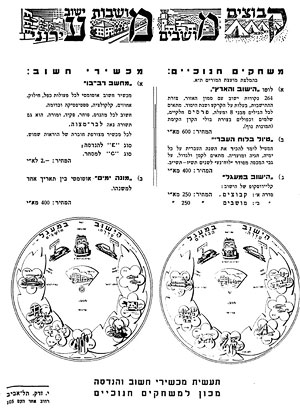 Up
Up
|
|

|

|
Jacob Zedak’s wooden slide rule |
|
|
|
|
What’s so special about a wooden slide rule,
you ask? And indeed, for most of their 3˝ centuries of existence --
until the arrival of plastics -- the material of choice for making
slide rules has been wood... but that is the case with straight
slide rules. Circular slide rules, by contrast, were almost
exclusively made of metal, and later of plastic. Yet Jacob Zedak
chose wood as the raw material for his take on these disc-like
calculators; and he used plywood, which wouldn’t be used even in a
linear rule. He didn’t produce many of these slide rules, but one
did make its way into my collection. The device: The Zedak slide rule in my collection is 19.1 cm (7.5 inch) across, and made of plywood and paper scales under a protective celluloid cover. |
|
|
|
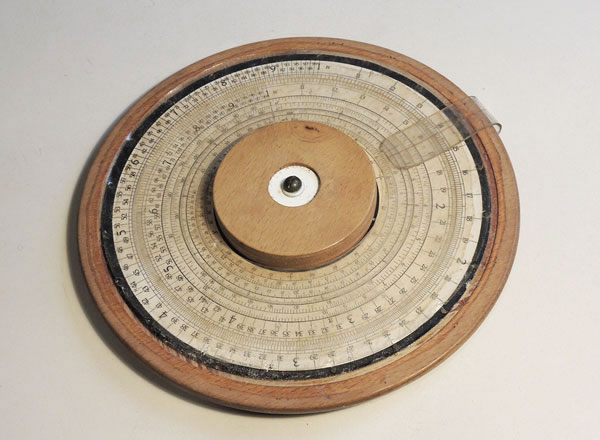 Click photo to enlarge |
|
|
|
This device uses a conventional format, with
a movable central disc (the slide) centered on a fixed circular
stock, and one radial cursor; but it has some interesting design
twists, as we shall see. The slide rule has eight scales. The outermost two -- one fixed on the stock, one on the slide inside it -- are one-cycle logarithmic scales, each some 43 cm in length (13.8 cm diameter). That’s much longer -- hence more precise -- than the 25 cm scale on a standard foot long straight rule. Next, moving inward on the slide, come scales for calculating Squares, Cubes, Logs, Sines, Tangents, and the innermost scale is for small-angle Sin and Tg. Each scale is marked –- n, n', n2, n3, etc. –- at its beginning. (See here a full photo of all scales). The move from small to larger angles is hinted at by the unusual arrows seen in the photo at left. The photo at right shows how Zedak crammed 2-digit numbers into all parts of the main scales, by staggering the captions between 41 and 99. |
|
|
|
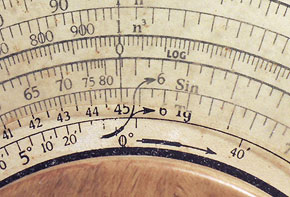
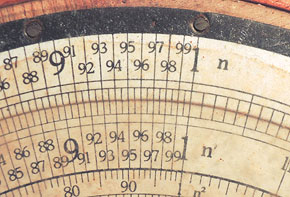 Click a photo to enlarge |
|
|
|
The scales are printed on paper and covered
by a protective transparent layer (in celluloid or some similar
material) which is nailed to the stock at its edges. The cursor is a
folded celluloid strip and curves from the back, where it is hinged
at the center of the stock. The most interesting feature of this device is the wooden knob, 7 cm across and 1.2 cm thick, that allows you to rotate the slide. Rotation of circular slide rule slides usually involves pressing the fingers of two hands on the surface and relying on friction to move the disc; some slide rules even have knurled areas on the disc to help with this action. But the Zedak rule offers this huge fat knob that you can grab with one hand and rotate with great ease and precision (for an opinionated piece on the advantages of round knobs see my post here). |
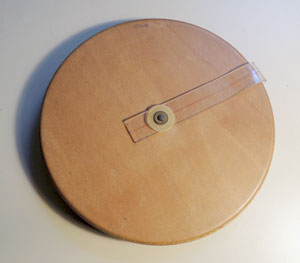 Click photo to enlarge |
|
|
|
At the very edge of the outer scale, in a tiny font, is the inscription “Copyright by J. Zedak, Tel-Aviv”. This photo also shows how the celluloid layer has shrunk and torn off two of the nails that had fixed it to the stock. |
|
|
|
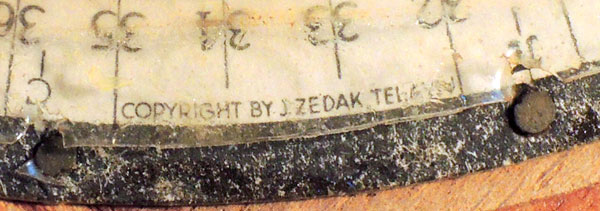 Click photo to enlarge |
|
|
|
The stock and knob are both cut from plywood,
whose outer layers are apparently of Beech, a useful and inexpensive
hardwood widely used by carpenters in this country to the present
day. The maker: The only bit of information I’ve managed to find about Jacob Zedak is that he came to Palestine from Poland in the 1940s. Since the “Guide to automatic calculation” mentioned below is dated “Tel Aviv 1942”, he must have come during (or, if the source is wrong, just before) WW2. Either way, he was lucky to escape the holocaust. But although we know nothing more of the man himself, Zedak did leave us traces of his business, which he defined on one product as a “Manufactory of calculating and engineering instruments -- Institute for educational games”. This small business produced circular slide rules, all following the same pattern but in at least two different sizes; I’ve seen images from online auctions of three different 7.5-inch rules and one 6-inch version. Even in the same diameter, there are variations in knob size, scales and cursor shape. |
|
|
|
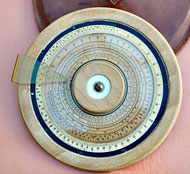
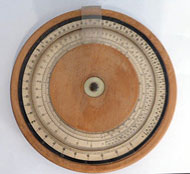
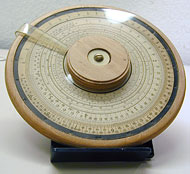 Click a photo to enlarge Left -- 6
inch version . Center -- 7.5 inch version
without trig scales. |
|
|
|
|
|
|
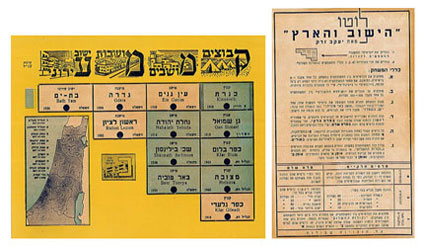
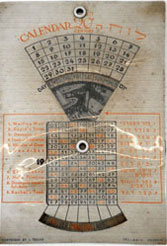 Click a photo to enlarge Left and center -- Lotto game of towns and villages. Right -- calendar slide chart of the 20th century. |
|
|
|
I was delighted to find in Israel’s National
Library the “Guide to automatic calculation according to the Rav-Bo
computer”, which is the advertised instruction booklet. “Rav-Bo” is
a contrived Hebrew term meaning “Much in it”, in the sense that the
computer is of manifold uses. The
booklet holds 24
typewritten pages, explaining the slide rule’s operation with
numerous examples from the commercial and agricultural domain (“A
ship was laden with 27000 cases of fruit for shipment abroad. On
arrival at destination 2250 cases of rotten fruit were found. What
is the percentage of rot?”). This commercial orientation is affirmed
in the introduction, which begins “The ‘Rav-Bo computer’ is to the
office as a ‘logarithmic ruler’ is to the engineer”. This booklet
lacks any reference to the trig scales, so I surmise it is related
to the commercial version, where my unit is the engineering version.
It is clear that Mr. Zedak took his art seriously, and spared no effort to produce a quality product: his scales are printed with precision down to the smallest numbers near the center, the wood is smooth and well-finished with matte lacquer, and the slide moves smoothly and without any “play”. Unfortunately, he could not overcome the constraints of the materials and techniques available in 1940’s Tel Aviv: his cursor has some freedom at the pivot, which itself is made crudely from a screw hammered at the back side like a rivet of sorts. Worse still, the celluloid covering the scales has shrunk over the years and torn itself from almost half the nails that held it to the stock; and these nails have rusted. The device still manages to give a pleasing impression and smooth operation, but it is obvious that a good machine shop and better materials would have served Zedak well -- had they been available to him. But then again, here is another device illustrating my favorite definition of Engineering -- “the art of making what you want from things you can get”. Wayda go, Jacob Zedak! |
|
|
|
Exhibit provenance: eBay, from a Judaica seller in Israel. More info: |
|
|
|
|
|
|
|
Home | HOC | Fractals | Miscellany | About | Contact Copyright © 2020 N. Zeldes. All rights reserved. |
|
